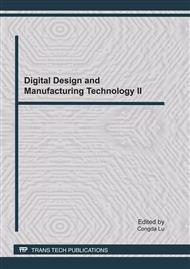p.1
p.5
p.9
p.14
p.19
p.25
p.29
p.33
Cutting Performance of Carbon Fiber Reinforced Plastics Using PCD Tool
Abstract:
Carbon fiber reinforced plastics (CFRP) has been widely used in airplanes, spaceships and automobiles. The cutting performance of CFRP with a fiber orientation of 0/45°/90°/135° has been studied at different cutting parameters by using PCD tools. Experiences subjected to orthogonal cutting were performed to investigate the effects of cutting parameters on cutting force, surface finish criteria (delamination) and roughness. Results show that CFRP can be milled by high speed and can get good surface quality with low delamination by using PCD tool. The cutting force decreases under the condition of decreasing the cutting width as well as the feed per tooth and raising the cutting velocity. The cutting force is a key point to control delamination that it should below 200N to get comfortable result. As for roughness, when the cutting force below 250N, the more cutting force, the higher surface roughness, and the trend changes when cutting force over 250N. The relation between cutting force and delamination, cutting force and roughness are obtained respectively through multiple regression analysis.
Info:
Periodical:
Pages:
14-18
Citation:
Online since:
March 2011
Authors:
Price:
Сopyright:
© 2011 Trans Tech Publications Ltd. All Rights Reserved
Share:
Citation:


